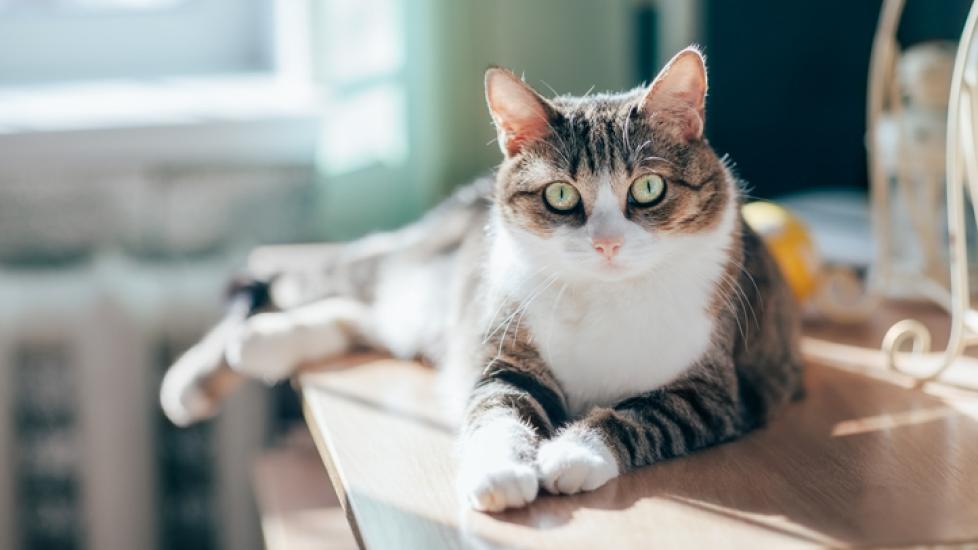What Is the Weight of an Average Cat, and When Is My Kitty Obese?
In 2018, the American Veterinary Medical Association (AVMA) classified obesity as a disease, with 59.5% of cats being clinically overweight or obese.
Carrying excess weight makes your cat much more likely to develop diabetes, urinary disease, arthritis, and to have a decreased life expectancy.
But many cat parents have a hard time evaluating their cat’s weight. You might think your cat is just a little chubby, but they could be more overweight than you think.
On the other hand, your cat might actually be underweight or losing weight without you noticing. Unexplained weight loss in cats can be a sign of serious health issues or diseases, so it’s crucial to know what your cat should weigh and to monitor their weight gain or loss.
So, what is a healthy weight for a cat?
What Should the Average Cat Weigh?
Typically, the ideal weight for the average healthy cat is 8-12 pounds.
That said, healthy cats come in a variety of sizes—and that includes weight. More than the weight alone, we must evaluate the body frame size and the lean muscle mass of a cat to determine what a healthy weight is.
Vet Recommended Health Support
How Is a Cat’s Ideal Weight Determined?
To account for all of the variables (body frame, lean muscle mass, etc.) and make this evaluation less subjective and more standardized, veterinarians developed the Body Condition Score chart.
This chart categorizes the body condition of a cat on a 9-point scale—with 9 being morbidly obese and 1 being extremely emaciated. Ideally, your cat should fall into the 4-5 range.
How to Use the Body Condition Score Chart
To use the body condition score chart, you need to physically and visually evaluate your cat.
A healthy cat has only a very small amount of fat covering their ribs. So when you run your hands over the rib cage, you should be able to feel the ribs without having to search through a layer of fat.
A cat’s fluffy coat can make it difficult to visually evaluate their body, but there are some strategies you can use. Stand above your cat and look down. Your cat’s body should have a slight hourglass shape as the abdomen tucks in a bit behind the rib cage.
When you look at your cat from the side, their body should only very slightly tuck up behind the rib cage and have a very minimal abdominal fat pad.
If you are unsure of where your cat falls on the chart, ask your veterinarian to assess your cat’s weight and body condition score to provide you with appropriate feedback.
Does the Average Healthy Cat Weight Vary Amongst Breeds?
The difference in body size between cat breeds can be significant.
Some breeds, like the Abyssinian, are long and lithe with delicate features. These more petite cats can have a healthy body weight of as little as 6-8 pounds.
Maine Coon cats are bred to have a medium to large body frame with broad chests and strong features. This big breed may have a healthy body weight of over 20 pounds.
The best way to learn if your cat is at a healthy weight is to work with your veterinarian. They can account for the variables (body frame, muscle mass, and breed) in order to determine what your cat’s ideal healthy weight is.
And through annual checkups, you can ensure that your cat is maintaining their healthy weight into their adult and senior years.
Does Your Cat’s Age Affect Their Weight?
Age and life stage can affect your cat’s weight. In kittenhood, cats will grow rapidly and gain weight quickly, but this is healthy and all part of the growing process.
After your cat is spayed or neutered, their metabolism may change, making it more likely for them put on excess weight. As they age, most cats put on excess pounds due to their changing metabolism and more sedentary lifestyle. It’s important to work with your veterinarian at annual check-ups to assess how your cat’s weight is changing from year to year.
Geriatric cats, however, may develop medical conditions such as kidney disease or hyperthyroidism that can cause weight loss. Unplanned weight loss is also a concern for cats, and older cats need to be monitored carefully to ensure they stick to a healthy weight.
How to Keep Your Cat at a Healthy Weight
Regularly working with your veterinarian to monitor your cat’s weight is the best way to keep your kitty healthy. And outside of vet appointments, there are things pet parents can do at home to keep their cat trim.
1. Don’t Free-Feed
While leaving kibble out all the time is convenient, most cats will overeat when given this free-feeding opportunity. Measuring out and feeding specific meals will help your cat regulate how much they are eating. To make mealtimes more fun, try puzzle feeders, interactive feeding toys, or automatic feeders.
2. Get Your Cat Moving
While cats are not as prone to wanting exercise, increasing their activity can help them maintain a healthy weight. A 20-minute play session a few times per day can help get your couch potato kitty up and moving.
Laser pointers and wand toys make for interactive and fun play sessions. And if you don’t have time in your schedule to play every day, interactive toys can help your cat play on their own.
3. Be Mindful of Treats
Watch those treats! Our fur babies deserve treats, obviously, but don’t overdo it. Those treats can quickly add up in extra calories.
Featured Image: iStock/Viktor_Gladkov
